Introduction to Comparative Planetology
“Comparative planetology as a philosophical genre. It studies different visual and philosophical cultures of imagining our planet, the earth. Comparative planetology maps these cultures and imaginations into a geopolitical realm. Because different imaginations of the planet reflect different geopolitical arrangements. These geopolitical realms are then translated into different geophysical and biochemical realities on the planetary scale.” (Lukáš Likav?an, 2020)
This is how Lukáš Likav?an described his version of comparative planetology, as he develops it in his book Introduction to Comparative Planetology. Known in astronomy as a branch that deals with the condensed matter of the solar system, especially with the planets and their moons, planetology usually deals with the physical (Merriam-Webster Dictionary, 2021). Likav?an on the other hand assigns comparative planetology to a less tangible realm. He investigates various visual and philosophical cultures and their repercussions on the planetary scale instead of only looking at the ongoing realities such as classic planetology would do.
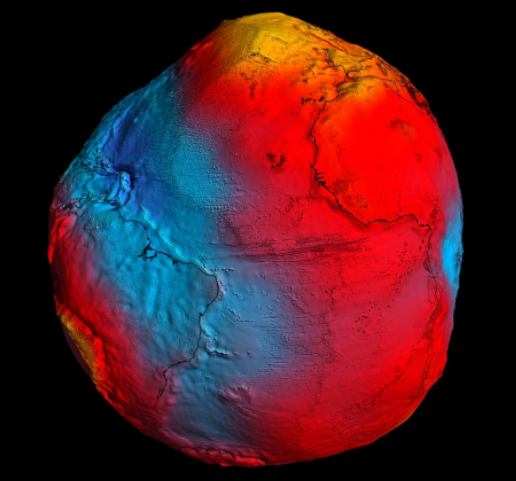
Earth’s gravity field. Image: ESA/HPF/DLR
Planetary Perspective
In a world where posthumanism is becoming more and more apparent, Introduction to Comparative Planetology provides a starting point to question our view of the world we live in. Through multiple different planetary views, an understanding of the larger spectrum of imaginations is obtained. The large shifts in between the views on the spectrum all showcase human and societal values throughout history, as well as the complexities that make up a certain planetary view. The last view presented in the book, The Spectral Earth, aligns itself with the future (or currently ongoing) shift towards posthumanism (Lukáš Likav?an, 2020). As argued by Rosi Braidotti, the posthuman helps us make sense of our flexible and multiple identities. (Rosi Braidotti, 2013)
Referred to as ‘planetary’ Likav?an’s five views indeed all operate on a planetary scale and encompass the whole planet, known to humans as the earth. This scale is often used outside of planetology as well. Fields such as politics and economics are all being rethought on the planetary scale in pursuit of holistic approaches that benefit all humans. Even the planet’s biggest enemy, climate change, is assessed through planetary boundaries. The planetary has simply become a standard of the scale on which problems need to be addressed to fight current global crises.
[The Planetary] – [The Globe] – [The Terrestrial] – [Earth-without-us] – [Spectral Earth]
As designers, designing in this planetary society and addressing these crises, we have to ask ourselves one important question. What planet are we designing for?
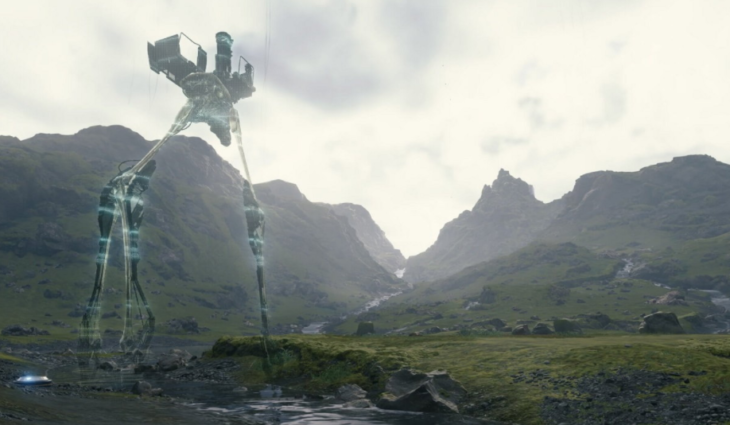
“Death Stranding”, game in a near-future setting full of supernatural events. Image: Kojima Productions, 2019.
The Spectral Earth
Chosen from the five views (listed above), the Spectral Earth imagination stood out and its characteristics became the basis of this theoretical reflection on which planet we, as designers, are designing for:
As far as natural sciences tell us, every known biological species comes with an expiration date. In this respect, homo sapiens is no exception. The problem is thus not so much about whether we will become extinct, but how we will cope with the truth of that extinction, as well as the ongoing extinction of other species. We believe that the notion of extinction brings vital conceptual relevance to design tactics for our present situation of environmental emergency.
Conditio Posthuma
In particular, one might construct the concept of extinction as a species-level analogy to individual death and develop certain conclusions regarding the constitutive role of extinction in the apprehension of geological time and planetary scale. Some even say that we are already living our extinction: Spanish philosopher Marina Garcés theorizes about the so-called conditio postuma. Instead of speaking about the post-human, she prefers to talk about the posthumous condition:
“Our »post« is that which comes after the after a posthumous post, a time of deferment we give ourselves when we have conceived and in part accepted the real possibility of our own end (whether of our world or the end of the human species as such).” (Marina Garcés, 2017)
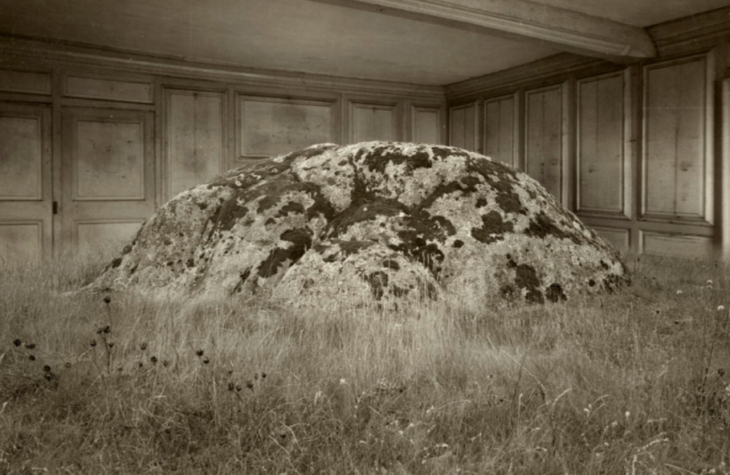
“Geologia” by Pablo Genovés, 2014. Image: Pablo Genovés.
Such a condition might be assessed by some as a reason for pessimism and defeatism. Yet this would be misleading since there is no reason to associate human centrality and importance in the planetary assemblage with hope and optimism, or the de-centring of the human with nostalgia, melancholy, and defeat. On the contrary, conditio posthuma brings about the possibility of living with the truth of extinction, i.e. living with the spectre of the future death of our species.
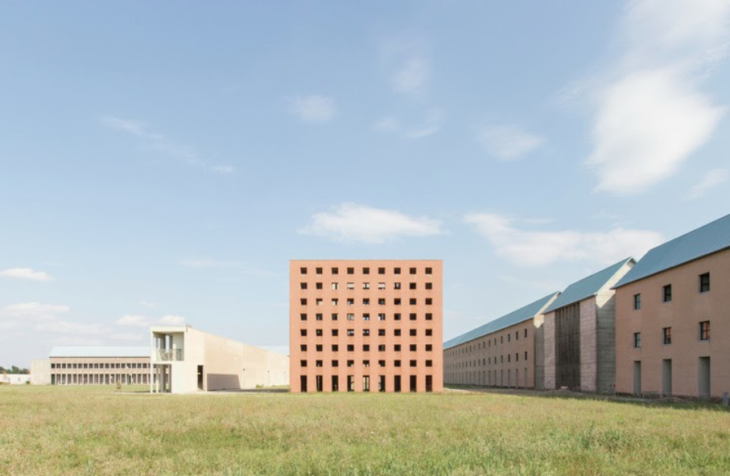
The cemetery as the foremost architectural expression of mourning and extinction. San Cataldo cemetery, Aldo Rossi (1971). Image: Laurian Ghinitoiu.
Mycelium as a response to the Spectral Principles
The key characteristics for this spectral earth are defined as follows:
- Confrontation with the continuous extinction of species.
- Conditio Posthuma as the state of all things.
- Sense of presence through ancestrality and posteriority.
- Spectral Earth is neither a world to win, nor to save. It is a world to be mourned.
In response to these characteristics, we propose the use of fungi, mostly mycelium, as a non-human design agent for posthuman architecture. Fungi are nature’s way of breaking down organic material, they are mostly made up of a mycelium. Mycelium consists of a web of filaments known as “hyphae,” which act as a natural binder and expand to form massive networks known as “mycelia.” They grow on their food, secreting enzymes, to break down sugars. The fast pace at which they do this plays a vital role in how things get recycled in our ecosystem. (J. Sheridan, 2020)

Forming of mycelium through the growth of a dense hyphal network. Image: Micropia.
- Mycelium as a new beginning. In response to the continual extinction, mycelium can grow independently, feeding on organic matter. Through its growth it spreads on, under and through that matter. While doing so, mycelium becomes a platform for either new life or for any not extinct species to carry on their respective lifecycle until extinction. Mycelium feeds on extinction and becomes a new beginning in itself.
- Mycelium as a living structure. Mycelium has strong potential as a building material and many applications are researched in the current academic landscape. Beyond being compacted into bricks after killing the material, it is the living fungi that become new responsive building structures. The living organisms can be the first to react to external impulses. A new realm of interactions with building materials can be part of the standard in the spectral earth.
- Mycelium as a healing agent. Through chemical reactions, strong bonds formed between the mycelium and any ancestral material can heal those materials. With or without the goal to preserve a structure, mycelium is a powerful agent to can bring back to life previously forgotten entities. These entities are then either restored to their lost glory or they are simply reintroduced in the present state of things with an extended lifestyle.
- Mycelium as a free organism. As a non-human design agent mycelium embodies a posthuman condition by its own existence. Without any human interference, it grows on its own, reacting to its environment. If regarded as an equal species to others, the hyphae networks, can manifest themselves on the spectral earth and take their rightful place.
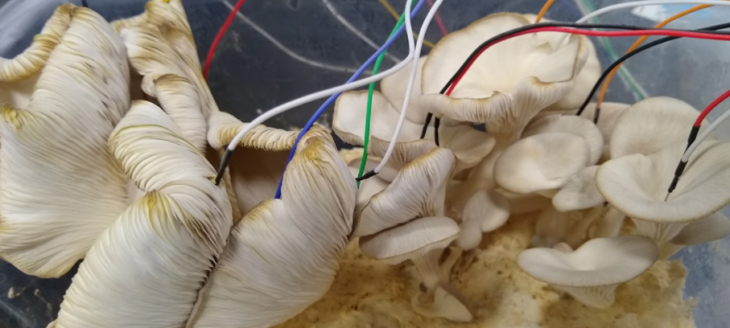
Fungi embedded with electronics to act as sensors. Image: UWE Bristol.
These spectral earth applications of mycelium showcase its value as an organic material with the capacity the deal with extinction on multiple levels. It is by studying and implementing mycelium frameworks within the context of architecture that one can truly understand the refined elements that create the spectral earth theory within the planetary philosophy.
Spectral Earth – Mycelium and Posthuman Architecture is a project of IAAC, the Institute for Advanced Architecture of Catalonia, developed during the Master in Advanced Architecture (MAA01) 2020/21 by students: Aishwarya S R, Jett Demol, Harshul Goti, Preetam S P, Zachary Eisenberg; faculty: Manuel Gausa, Jordi Vivaldi.
List of References
- Braidotti, Rosi. The Posthuman. London: Polity Press, 2013.
- Garcés, M. “Conditio Posthuma”, in The Great Regression, ed. Heinrich Geiselberger, 2017.
- Likav?an, Lukáš. Introduction to Comparative Planetology. Moscow: Strelka Press, 2020.
- Likav?an, Lukáš. Introduction to Comparative Planetology. Lecture at Strelka Institute, Moscow, 24 June 2020.
- Sheridan, J. “How fungi can help create a green construction industry”. The Conversation, 2020.
- “Planetology.” Merriam-Webster.com Dictionary, Merriam-Webster.